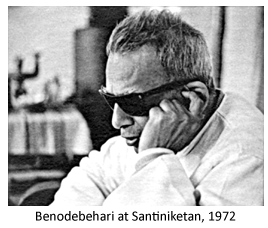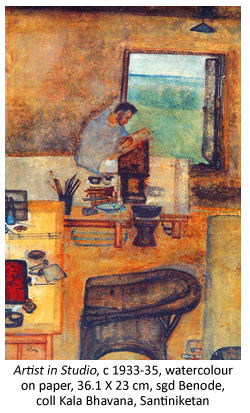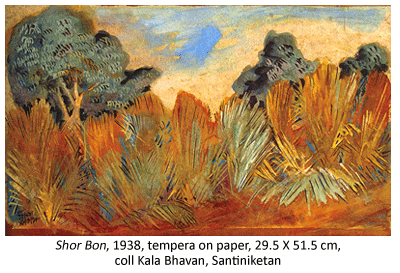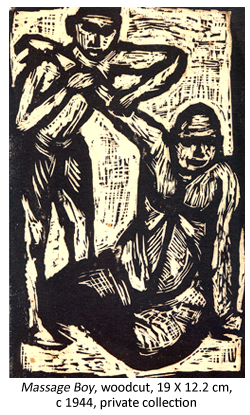- Prelude
- Editorial
- Manjit Bawa
- Husain's Calcutta
- Vivan's Visionary Reconstruction of History at Victoria Memorial, 1998
- The Remaking of Indian Painting
- Picasso Re-visited
- Benodebehari Mukherjee: A Recluse and the Centenary Show
- In Past and Present Continuum Speaking to Thota Vaikuntam
- The Importance of Being Husain
- Image-making to Image-circulation: Implicated Image(ry)
- 153 Years Old yet Young at Heart: Mumbai's Sir JJ School of Art
- Two Decades: A Critical Insight by an Art Critic and an Artist
- Biedermeier Style: Biedermeier Furniture
- Vacheron Constantin
- The Irony of Andy Warhol
- Then and Now: An Indian Perspective to the Art Market 1990-2010
- Pablo, Andy, Here I Come
- What Happened and What's Forthcoming
- Bid's Got Hammered?
- Anish Kapoor at National Gallery of Modern Art in Delhi and Mehboob Studio in Mumbai
- Tribute to Hemanta Misra: the “Calcutta Group” Painter
- Art Events Kolkata
- Mumbai Art Sighting
- Art Bengaluru
- Exploring the Riverine Culture of Bengal
- Alternative art practices define Bangalore
- India Art Summit Turns Three
- An Aesthetic Fair
- SSVAD: A New Arts Centre in Santineketan
- Visible Invisible by Siraj Saxena
- A Fleeting World : Paintings by Sunil De
- Previews
- In the News
ART news & views
Benodebehari Mukherjee: A Recluse and the Centenary Show
Volume: 3 Issue No: 12 Month: 1 Year: 2011
by Soumik Nandy Majumda
'My objectives have always been around an artist's ultimates – have sought to know myself, and in the process unfold it to others, never forgetting that I am just one amongst the many.' from Chitrakar
Centenary Retrospective exhibition of Benodebehari Mukherjee curated by Gulammohammed Sheikh and R Siva Kumar organized by the Director, the NGMA, Prof Rajeev Lochan from December 30,  2006 to February 11, 2007
2006 to February 11, 2007
This modestly worded statement almost summarises what art and life inseparably meant to Benodebehari Mukherjee (1904 - 1980). Confessional in nature, these words also betray a deep faith in one's self and a silent refusal to accept anything for granted. He lived and worked in an ambience that by and large was fostering the ideas of revivalism, nationalism and later, the more diversified modernist trends of post-independence era. Yet Benodebehari followed a markedly independent course of artistic odyssey. A person with an unflinching individuality, Benodebehari, in the words of Prithwish Neogy, 'was independent almost to the point of being lonely'. A self reliant artist, he generally kept to himself staying away from limelight, and quietly committed himself to the multiple roles of an uncompromising artist, a resourceful and dedicated teacher and a discerning writer on art.
While Benodebehari's significance needs to be reappraised in the larger context of modern Indian art, Santiniketan as a specific context, as his alma mater, played an undeniable role in shaping his artistic aims and ideas. In Santiniketan he came in touch with great personalities like Rabindranath Tagore and found a remarkable teacher in Nandalal Bose. Moreover, the educational environment of Santiniketan and Kala Bhavana in particular was conducive to his eclectic bent of mind, providing him with a wide range of inter-disciplinary experiences and cross cultural exposures. All these factors in combination contributed to the development of his sharp and insightful perception. But what perhaps influenced him most was the rustic, irresistible nature in and around Santiniketan.  Reminiscing later in his widely acclaimed literary masterpiece, 'Chitrakar' (1979), Benodebehari wondered who his real teacher was. Giving due respects to Nandalal Bose, and the wonderful collection at Kala Bhavana library, he finally admitted that the stark and arid image of the local environment and its simple, sturdy people greatly inspired him to paint as he did. He did remain very close to nature, in more than one way, throughout his life.
Reminiscing later in his widely acclaimed literary masterpiece, 'Chitrakar' (1979), Benodebehari wondered who his real teacher was. Giving due respects to Nandalal Bose, and the wonderful collection at Kala Bhavana library, he finally admitted that the stark and arid image of the local environment and its simple, sturdy people greatly inspired him to paint as he did. He did remain very close to nature, in more than one way, throughout his life.
Born on 7th of February 1904, to a middle class family in Calcutta, Benodebehari was gifted with the power of a keen observation. He passionately observed the visual world around in graphic detail. These keen observations made him more sensitive to his surrounding. Later in Santiniketan where he arrived in 1917 to take admission in the Brahmacharyashram School, this sensitivity got further enhanced.
Even before Visva-Bharati was formally founded, Kala Bhavana came into being in 1919. With Nandalal Bose as the Principal and Rabindranath Tagore as the mastermind, Kala Bhavana was trying to chalk out a pedagogical methodology afresh. The process was experimental, and emphasis was laid on individual creative expressions in place of a prescribed academic schooling. Benodebehari soon got engrossed into it and wasted no time in learning and absorbing what this new art school had to offer.
Benodebehari started teaching at Kala Bhavana from 1925 and continued till 1948. Within this span of twenty-three years the only time he took a break was in 1937-38 when he went to Japan.  While he was deeply involved in teaching, his own paintings were gaining in an unmistakable strength and individuality.
While he was deeply involved in teaching, his own paintings were gaining in an unmistakable strength and individuality.
Turning away from the prevalent trends of painting romantic landscapes, mythological illustrations or nationalist subjects, Benodebehari was finding his themes in everyday scenes and the pastoral life around. For this he was largely depending on the observed visual facts and searched for a suitable pictorial idiom. He took lessons from the indigenous traditions but was never in favour of a stylistic or manneristic revival. But he certainly realised the importance of a thorough knowledge of the formal aspects and skill inputs of visual language and meticulously learned and practised various kinds of mediums like pen and ink, brush and ink, water colour, tempera, gouache, oil colour, fresco painting, wood cut, lino cut, dry point, lithography, modelling in clay and wax, and collages. Instead of imposing a uniform style on all these mediums, he responded eagerly to the curious demands of each medium, exploring his principal preoccupation with image and its possible articulations.
Till 1940's Benodebehari was primarily a painter of nature. In his landscapes and paintings of trees and flowers, he is evidently concerned with the structural organisation of a pictorial space. Completely circumventing any mimetic representational style he builds up a parallel structural autonomy which oscillates between the observed fact and itself. With this kind of compositional concept, obviously Benodebehari had to do away with any static view point and he devised a pictorial equivalence of a moving spatial experience. This was hardly a pure conceptual construct but a complex perceptual system originating out of his perception of the desolate, undulating land of Birbhum countryside, specifically the khoai (parched earth). In the 30's Benodebehari was exploring the possibilities of depicting the wilderness of Birbhum landscape in the horizontal scroll format of several feet. This format, which is imbibed from Far Eastern tradition, provided him with the opportunity of spreading the composition horizontally, thus accentuating the vastness of the space and a sense of movement unfolding laterally.  He occasionally punctuated this barrenness with spaced out vegetations, lonely palm trees or clusters of tall trees, all culled from the local surrounding. But the rugged vastness of local countryside apart, it was also the sensuous comprehension of nature in its physical form which changed the tenor and mood of the experience of nature in these scrolls.
He occasionally punctuated this barrenness with spaced out vegetations, lonely palm trees or clusters of tall trees, all culled from the local surrounding. But the rugged vastness of local countryside apart, it was also the sensuous comprehension of nature in its physical form which changed the tenor and mood of the experience of nature in these scrolls.
Complementary to the scroll format was Benodebehari's calligraphic technique of using eloquent lines, expressive marks, surging strokes, swift hatchings and even local colour-patches which endowed the images with a gestural quality marked by spontaneity, brevity and precision. By employing calligraphic rendering he infused his images with a sense of both immediacy and a premeditated accuracy. With this calligraphic skill Benodebehari gave fresh configurations and a pictorial dimension to Bengali scripts. He worked on this art of hand writing, and created several pieces of calligraphic scripts.
From late 30's till late 40's, Benodebehari, beside other things, devoted a considerable amount of time to the art of mural painting. In the process not only did he attain a thorough knowledge of the techniques of different mural traditions, he also created novel imageries in magnificent visual dimensions and great conceptual depth. Kala Bhavana dormitory ceiling mural (1940) for instance, though seemingly decorative, is an ever growing space replete with descriptive images of Birbhum folk life and nature, requiring a sign by sign reading of the sharply articulated details. In the later murals however, landscape and nature take a relatively back seat, human figures instead appear with great vivacity on these walls as evident in the Cheena Bhavana mural (1942). In the Hindi Bhavana mural (1946-47), considered to be the magnum opus of Benodebehari, the message and significance of the great saints of medieval India are reinterpreted in a visual language reinvested with contemporary world view of the artist. With its emphatic spatial dimensions, strong gestural language, metaphorical imageries, and allusions to a multicultural and liberating Bhakti tradition of medieval India, '...as much as it is about the saints', Geeta Kapur writes, 'the mural is about the daily life of the people'. She further writes, 'Portrayed in curious, tender detail and highly particularized, all the figures share this one characteristic : they are eager participants, inalienable parts of a life force – a work force one might say – released from drudgery and servitude because of a sense of belonging'.
In the hands of Benodebehari mundane, matter of fact visuals get transformed into a meaningful artistic configuration. The sketches and notes of Benares gave birth to a number of splendid drawings and paintings of Benares ghats and its locales. The bustling ghats peopled with all kinds of men and women are delineated with multidirectional strokes and lines, turning sketchy impressions of flux into a spontaneously organised grand spectacle.  The self-assured strokes, the economy of means and the misleadingly simplistic look of these works have a parallel streak of spontaneity which makes the pictures immediate and lively along with a sense of permanence. Devoid of all non-essentials, shorn of any frills, Benodebehari's works arrive at the stage of bare essentials, as if he is, in KG Subramanyan's words, 'beginning with the beginnings.'
The self-assured strokes, the economy of means and the misleadingly simplistic look of these works have a parallel streak of spontaneity which makes the pictures immediate and lively along with a sense of permanence. Devoid of all non-essentials, shorn of any frills, Benodebehari's works arrive at the stage of bare essentials, as if he is, in KG Subramanyan's words, 'beginning with the beginnings.'
The Benodebehari Mukherjee Birth Centenary Retrospective Show held in the National Gallery of Modern Art, New Delhi from the 30th of December 2006 to 11th February 2007 brought us back not only to the temporal zone wherein the artist lived and worked but also to the fundamental artistic search and working process Subramanyan is talking about.
This commendable show was unquestionably a fitting tribute by the two curators renowned painter and writer Gulammohammed Sheikh and distinguished art historian R Siva Kumar to this master artist who went rather unnoticed by the larger section of art enthusiasts. Needless to say, these two curators had to work painstakingly to get hold of the innumerable works spread in various collections all over the country. One of the major curatorial focal point was bringing together the entire range of works which consisted of drawings, paintings, water-colours, paper-cuts, prints, wood-block prints on textile and sculptures.  The retrospective includes a wide selection of over 400 works from the oeuvre spanning over sixty years.
The retrospective includes a wide selection of over 400 works from the oeuvre spanning over sixty years.
A significant curatorial intervention in this show was to reproduce and display digitally enlarged images of Benodebehari's murals. All the mural reproductions were being shown for the first time ever outside the venue of the originals. The life size (digital) reproduction of the 80 ft mural called Medieval Saints originally at Hindi Bhavana, Santiniketan was an astonishing exposure for the viewers. Speaking on this venture Gulammohammed Sheikh in an interview to Jayaram Poduval for www.mattersofart.com says, 'Here in the retrospective we wanted to display even the Hindi Bhavan mural in its entirety to address two objectives. One, we wanted to bring it to the notice of the people that such a major work of the 20th century Indian art is there right in front of us and we wanted to project it as a major attraction of the retrospective. Secondly, we also wanted to draw attention to the fact that these murals have been damaged, so that, proper attention can be paid towards the need for their restoration.' To further augment this responsiveness the show came up with a number of publications highlighting various aspects of Benodebehari's artistic journey. The curators also decided to play during the show the well-known documentary film called Inner Eye made by Satyajit Ray who was Benodebehari's student and a great admirer.
Throughout his life, both as a resourceful teacher and an unflagging painter Benodebehari kept exploring the cultural interfaces where art and craft traditions may have a common ground. In 1948 Benodebehari left Santiniketan and went to Nepal to take over as the curator of the Nepal Govt Museum, Kathmandu where he was particularly moved to witness the living art and craft panorama of Nepal. In fact he came into close contact with some of the expert artisans of wood-carving and metal casting traditions of Nepal. Later During one of his many visits to Banasthali he even went to Jaipur and worked with the block-printers of Sanganer. Benodebehari supplied them with designs, done in linocuts and traditional printers printed them exquisitely along with their traditional motifs.
Benodebehari lost his eye sight completely after an eye operation in Delhi in 1956. Benodebehari, thus challenged, faced this new plight undaunted. This time he came back as a teacher of history of art in Kala Bhavana. As an artist he tried to negotiate with his loss of optical vision by working out different means of visual expressions like felt pen drawings on paper, drawings in lithography, collages with colour papers, modelling in wax and clay and building forms with folded papers.  This last technique was employed in conceiving the different motifs used in the ceramic tile mural on the wall of mural studio (1972) in Kala Bhavana.
This last technique was employed in conceiving the different motifs used in the ceramic tile mural on the wall of mural studio (1972) in Kala Bhavana.
Space, movement and tangibility attained a new meaning for Benodebehari now. Now he found a novel dimension of space which was measurable, negotiable and even combatable in a strangely and paradoxically tactile term. Yet the visible world for him turned dark for ever. During these days the way he continued drawing, collaging, and modelling unabated, it prompted Dinkar Koushik to remark that now Benode Behari had the light of vision at the tip of fingers.
Benodebehari had been writing articles on art and artists since 1930's. Almost all the well-known reputed Bengali journals had his articles published quiet frequently. Benodebehari's limpid language and clarity of ideas make these writings pellucid, unambiguous and thus salvaging the prevalent Bengali art writings from unnecessary verbosities and convolutions. Apart from the essays he also wrote a few fictional and autobiographical pieces which earned him wide acclaim from the informed literary circle as well as lay-readers.
Benodebehari realized that he was a born teacher. He evolved his own way of imparting knowledge which benefited the students immensely. As Riten Mozumder recalls, he would never touch our work but would demonstrate with small analytical diagrams. Being a very resourceful and ingenious teacher with a thorough grasp over the fundamentals, Benodebehari was a guiding light for the students. His legendary art history classes were innovative and addressed artistic problems and issues across time and place transgressing the curriculum boundaries.  The artist Benodebehari, the teacher Benodebehari, and the writer Benodebehari thus got indelibly associated with each other.
The artist Benodebehari, the teacher Benodebehari, and the writer Benodebehari thus got indelibly associated with each other.
Benodebehari Mukherjee passed away on 19th November, 1980. During the last decade of his life he received official honours including Padma Vibhushana by the Government of India (1974) and Deshikottama by Visva Bharati (1977). For the book Chitrakara, he received the Bharatiya Bhasha Parishad award (1980) and Rabindra Purashkar posthumously in 1981. The introvert person, who was known for his 'patent distrust of publicity', became a well known figure at the fag end of his life. Yet, the rigour in his practices, the self effacing character of his art, and his reserved personality kept him in a distance, almost in a meditative seclusion.
As Gulammohammad Sheikh said and Siva Kumar would certainly endorse that this curatorial venture was 'not just doing an exhibition, but it is something like a kind of a lifetime project … and it is the work of an artist one felt was not sufficiently recognized.'
By the same token, for us the viewers, the centenary show was a pilgrimage of sort. As my artist-writer friend KSS Murthy writes to me in a personal correspondence three years after visiting that show 'Benodebehari's art and life appear exceptionally charged in a very quiet way. The adjective 'quiet' means the ways in which one eschews persuasive, rhetorical, flamboyant means to reach ones objectives either in art or life. No wonder it took so much time for the press and the public to understand his importance in these times of glamour and glitter.'
7] Photo courtesy 1X1 Art Space, Dubai
8] Image courtesy The National Gallery of Modern Art, New Delhi & Mrinalini Mukherjee